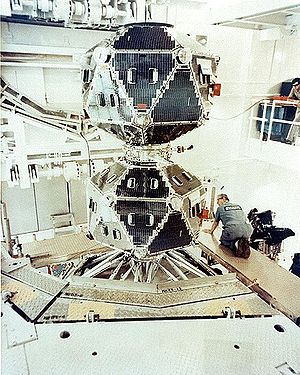12 January 2011
How Nuclear Weapon Treaties Led To The Discovery That Thunderstorms Produce Antimatter!
Posted by Dan Satterfield
NASA released a really cool piece of science this week. The story starts with the nuclear arms reduction treaties signed in the 1960’s between the U.S. and Russia. This was back in the middle of the cold war, and neither side trusted the other.
Probably for good reason.
So how could we be sure the Russians were not testing nuclear weapons without us knowing about it? Easy. Nuclear fission produces a very high energy form of light called gamma rays. This extremely short wavelength radiation could be detected. So all that was needed was to launch a series of satellites that would warn us if gamma rays were detected.
Guess what, the satellites started seeing lots of gamma ray flashes. HUGE FLASHES. These flashes were brighter in energy for a few seconds than the entire Universe!

VELA Satellites. These satellites were built to detect Russian nucleartests and to ensure compliance with test ban treaties. The ended up discovering gamma ray bursts
Were the Russians cheating?
It turns out not.
The gamma ray flashes were coming from all over the sky. The military folks let astronomers in on it and, to say the least, they were very intrigued.
Actually, they went berserk over it, and have been ever since!
Today, gamma rays are the subject of a tremendous amount of research. Satellites have been launched to detect these flashes and pinpoint them with high precision. It’s thought that some of these flashes are from super massive stars collapsing to form a black hole.
(If this interests you, watch Alex Fillipenko’s Intro. Astronomy course at U. California-Berkeley. Totally free and fabulous.)
NASA now has the Fermi Gamma Ray Space Telescope in low Earth orbit, and guess what it’s found? Gamma rays are coming from thunderstorms. This was actually discovered in 1994, but Fermi is indicating that about 500 gamma ray bursts are happening each day in the atmosphere. This is way more than expected.
Something much more interesting was recently discovered by Fermi. It passed over a thunderstorm in Zambia, and a few minutes later it detected a gamma ray burst. What was strange is that it shouldn’t have seen anything. The storm was over the horizon. How was this possible??
NASA scientists believe that gamma rays produced by the storm hit an atom in the right way and produced two nuclear particles. An electron and it’s antimatter opposite a positron.
A positron has positive charge but is otherwise like an electron. If antimatter hits matter it immediately annihilates. When this happens, gamma rays are produced.
So here’s how Fermi saw it:
The thunderstorm in Zambia produced gamma rays that hit an atom. This caused an electron and a positron to form. These particles were steered along the Earth’s magnetic field lines and hit the Fermi telescope. When the positron hit, it annihilated itself and produced gamma rays. This set off the detector on the telescope! Even though the thunderstorm was out of sight.
Thunderstorms are producing antimatter!
The real universe is so much weirder than the science fiction books make it out to be!




 Dan Satterfield has worked as an on air meteorologist for 32 years in Oklahoma, Florida and Alabama. Forecasting weather is Dan's job, but all of Earth Science is his passion. This journal is where Dan writes about things he has too little time for on air. Dan blogs about peer-reviewed Earth science for Junior High level audiences and up.
Dan Satterfield has worked as an on air meteorologist for 32 years in Oklahoma, Florida and Alabama. Forecasting weather is Dan's job, but all of Earth Science is his passion. This journal is where Dan writes about things he has too little time for on air. Dan blogs about peer-reviewed Earth science for Junior High level audiences and up.
[…] This post was mentioned on Twitter by Am Geophysical Union. Am Geophysical Union said: On the AGU Blogosphere: How Nuclear Weapon Treaties Led To The Discovery That Thunderstorms Produce Antimatter! http://bit.ly/g0IlAb […]
Very neat stuff! I’ll be sharing this with my teacher and classmates!
[…] Awesome video from NASA about how thunder storms make antimatter (requires Quicktime). The research that discovered this was instigated by 1960s nuclear arms reduction treaties. […]